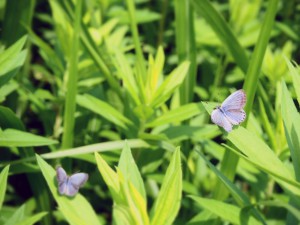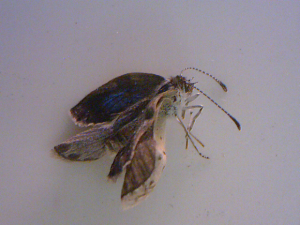
In this guest blog, Joji M. Otaki discusses the impact feasting on radioactively contaminated leaves has on the surrounding blue butterfly population.
The collapse of the Fukushima Dai-ichi Nuclear Power Plant in March 2011 is the second largest nuclear accident, next to Chernobyl, in the history of mankind. Many theoreticians and politicians have claimed, without any field-based or experimental evidence, that there are no harmful biological effects caused by the released artificial radionuclides.
Even worse, some biologists have claimed that there are no biological impacts in the polluted area, based solely on fragmentary data from a short survey or a non-informative experiment (or based on irrelevant data) that have no power to resolve the issue. These claims were often relatively well advertised.
However, this situation has changed in recent years. For example, it has already been reported that some animals, especially butterflies, decreased in number in the polluted areas in Fukushima, based on field surveys conducted by Prof. Timothy Mousseau and his colleagues. We have been working on the pale grass blue butterfly, Zizeeria maha, to evaluate the biological impacts of the accident (for example, see). We are sure that this species of butterfly was considerably affected by the accident, based on several field surveys, rearing experiments in our laboratory, external exposure experiments, and internal exposure experiments, some of which have already been published. The internal exposure experiments were performed in the previously published papers by feeding Okinawa larvae (least affected in Japan) leaves contaminated at high levels.

Now in the paper just published in BMC Evolutionary Biology, we tested if leaves contaminated at relatively low (or very low) levels from places where many people live could be harmful to this butterfly from Okinawa. As expected, leaves contaminated at very low levels (e.g., Okinawa, 0.2 Bq/kg; Atami, 2.5 Bq/kg) did not show any significant effect. However, to our surprise, leaves contaminated at relatively low levels, approximately 100 Bq/kg (e.g., Koriyama, 117 Bq/kg), resulted in a mortality rate of more than 50%. This result differs from the previous one which was based on leaves contaminated at relatively high levels (e.g., Fukushima, 7,860 Bq/kg; Iitate-flatland, 10,170 Bq/kg) see). Because the breeding lines used in these two experiments were different, the difference indicates sensitivity variation within this single species.
Indeed, in our experiments, a mortality rate never reached 100%, even in feeding leaves contaminated at extremely high levels. In other words, some are completely fine at least morphologically, but others are heavily ill or dead. Sensitivity to radiation varies very much among individuals.
The ingestional impacts appear to be transgenerational, as the body size (more precisely, the forewing size) of this butterfly decreased in the offspring generation. Moreover, the sensitivity of the offspring generation increased, resulting in very high mortality rates. Interestingly, feeding the offspring larvae non-contaminated leaves resulted in low mortality rates.

Of course, we do not know how much of our experimental results from the pale grass blue butterfly are applicable to humans. However, it is widely believed among modern biologists that insights obtained from one biological system are largely applicable to other systems. This is why biologists study model organisms such as the fruit fly, Drosophila melanogaster. Studies on this insect have greatly contributed to our understanding of humans.
To my knowledge, there have been no cases of human health effects of the Fukushima accident reported in scientific literature thus far, although anecdotal evidence has been around. To be sure, human-based studies are slow, descriptive, less conclusive, and more often a target of political pressure, compared with insect studies, but of course human studies are necessary. I believe that at least some studies on human health will appear sooner or later in scientific literature.
[…] Prof. Otaki: Many theoreticians and politicians have claimed [that Fukushima has caused] no harmful biological effects… Even worse, some biologists have claimed that there are no biological impacts… to our surprise, leaves contaminated at relatively low levels… resulted in a mortality rate of more than 50%… Moreover, the sensitivity of the offspring generation increased, resulting in very high mortality rates… it is widely believed among modern biologists that insights obtained from one biological system are largely applicable to other systems… […]
[…] Prof. Otaki: Many theoreticians and politicians have claimed [that Fukushima has caused] no harmful biological effects… Even worse, some biologists have claimed that there are no biological impacts… to our surprise, leaves contaminated at relatively low levels… resulted in a mortality rate of more than 50%… Moreover, the sensitivity of the offspring generation increased, resulting in very high mortality rates… it is widely believed among modern biologists that insights obtained from one biological system are largely applicable to other systems… […]
[…] source […]
[…] From BioMed Central: […]
[…] Are butterflies still fluttering in Fukushima? […]
[…] Prof. Otaki: Many theoreticians and politicians have claimed [that Fukushima has caused] no harmful biological effects… Even worse, some biologists have claimed that there are no biological impacts… to our surprise, leaves contaminated at relatively low levels… resulted in a mortality rate of more than 50%… Moreover, the sensitivity of the offspring generation increased, resulting in very high mortality rates… it is widely believed among modern biologists that insights obtained from one biological system are largely applicable to other systems… […]
[…] Prof. Otaki: Many theoreticians and politicians have claimed [that Fukushima has caused] no harmful biological effects… Even worse, some biologists have claimed that there are no biological impacts… to our surprise, leaves contaminated at relatively low levels… resulted in a mortality rate of more than 50%… Moreover, the sensitivity of the offspring generation increased, resulting in very high mortality rates… it is widely believed among modern biologists that insights obtained from one biological system are largely applicable to other systems… […]
[…] Prof. Otaki: Many theoreticians and politicians have claimed [that Fukushima has caused] no harmful biological effects… Even worse, some biologists have claimed that there are no biological impacts… to our surprise, leaves contaminated at relatively low levels… resulted in a mortality rate of more than 50%… Moreover, the sensitivity of the offspring generation increased, resulting in very high mortality rates… it is widely believed among modern biologists that insights obtained from one biological system are largely applicable to other systems… […]